Digital Screening of “Anjasa- Unravel the Wonders of Buddhist Monuments”
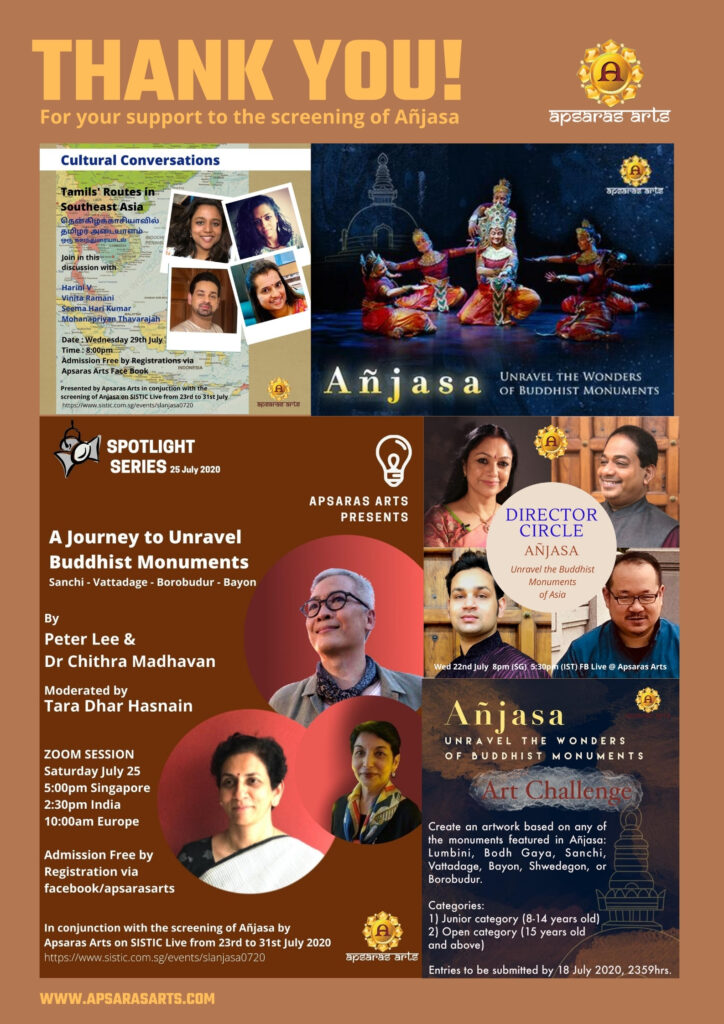
From 23rd July to 31st July “Añjasa”- Unravel the Wonders of Buddhist Monuments” was screened on SISTIC Live for viewers across the globe. Apsaras Arts production – Añjasa (pronounced as “Anyasa”) refers to “The Path” in Pali, the classical language of Buddhism explores the beauty of Buddhist temple architectures. The production takes the audience on a journey through monuments including Mahadevi Temple in Nepal, Bodhgaya Mahabodhi Temple and Sanchi Stupa in India, Vattadage in Sri Lanka, Shwedagon Pagoda in Myanmar, Bayon in Cambodia, Borobudur in Indonesia and Wat Pho in Thailand. The production also highlights the contributions of Buddhist emperors, Asoka and Jayavarman VII who were iconic in the spread of Buddhism across Asia. This dance production features company dancers from Apsaras Arts and a unique musical orchestra with music composed by an array of Singaporean artistes including Aravinth Kumarasamy who composed the score which comprised both classical Indian and Chinese instruments including the Er Hu, Yang Qin. The costumes and set design have been inspired by Buddhist iconography using color schemes of gold, saffron and red as found in Buddhist robes from India and Southeast Asia. Añjasa premiered in Singapore in January 2015 at Victoria Theatre and has toured to London, Liverpool, Manchester, Bangalore, Chennai, Colombo, Kuala Lumpur and Sydney. This digital screening is filmed at Nelum Pokuna Mahinda Raja Paksha Auditorium on 7th March 2017 presented by Ministry of Culture, Srilanka supported by National Arts Council, Singapore. Watch the dancers share their experience of the tour : Click here to watch This particular production and its show in Colombo bear special significance for the team at Apsaras Arts as it was the last production that Neila Mami blessed, as she breathed her last that same night. Watch Aravinth recall the memories of this Production : Click here To promote this digital screening, 3 unique talks were organized to showcase difference aspects of this production. On the eve of the screening, Directors’ Circle was launched. This is a new initiative that brings together behind-the-scenes insights from the people who created the production in a roundtable discussion. For this inaugural edition, Dancer-Choreographer Rama Vaidyanathan hosted Aravinth Kumarasamy (who created the concept, directed and composed the music), Mohanapriyan Thavarajah (who choreographed the dance sequences & designed the costumes) and Stanley Ang (who performed the Chinese instrument, Yang Qin). During this talk, they shared many details of their conceptualization and both Mohanapriyan and Stanley performed unique excerpts and shared the working philosophy and the research undertaken to depict the different elements of Buddhist architecture. Watch their conversation: Click here This was followed by an exclusive spotlight session with eminent heritage experts – Dr Chithra Madhavan (India), Mr Peter Lee (Singapore) moderated by Mrs Tara Dhar Hasnain (Singapore) on 4 specific Buddhist monuments – Sanchi, Pollorunuwa, Bayon & Borobudur. Here, they delved deep into the historic time period and the impact of these monuments to both the local environment and the composite identities that evolved over the centuries. This session was highly anticipated and we had over 70 attendees in a closed session. Finally, we organized a youth-oriented talk under our banner, Cultural Conversations with a session called “Tamils’ Routes in Southeast Asia.”. For the first time, this was bilingual talk in Tamil & English featuring 4 young Tamils – Harini Vee, Vinita Ramani, Seema Hari Kumar and Mohanapriyan Thavarajah who engaged and explore Tamil identity, historical routes within their roots as citizens of South East Asia. This talk allowed for open discussion on navigating fresh identities while taking cognizance of native Indian identity and layered local identities. The speakers spoke about the impact of classical India on South East Asia and how passing this on to future generations will always call for reflection and understanding of the past ideologies help appreciate and strengthen our appreciation of Tamil roots and heritage. Watch this Culture Conversation here : Click here A unique online Art Challenge was organised to garner interest in the production and the Buddhist monuments. Many young artistes participated in the junior’s category and used this opportunity to research and explore different artistic methods to recreate the monuments in charcoal, digital art, pencil work. The most popular monuments were Sanchi and Borobudur. The winners of the final round received Amazon cash vouchers and an opportunity for their artwork to be featured as part of Añjasa’s overseas tours in coming years. The many who watched this screening praised the performance and the splendour of the work created.
Review Corner August 2020 (Virtual Events)
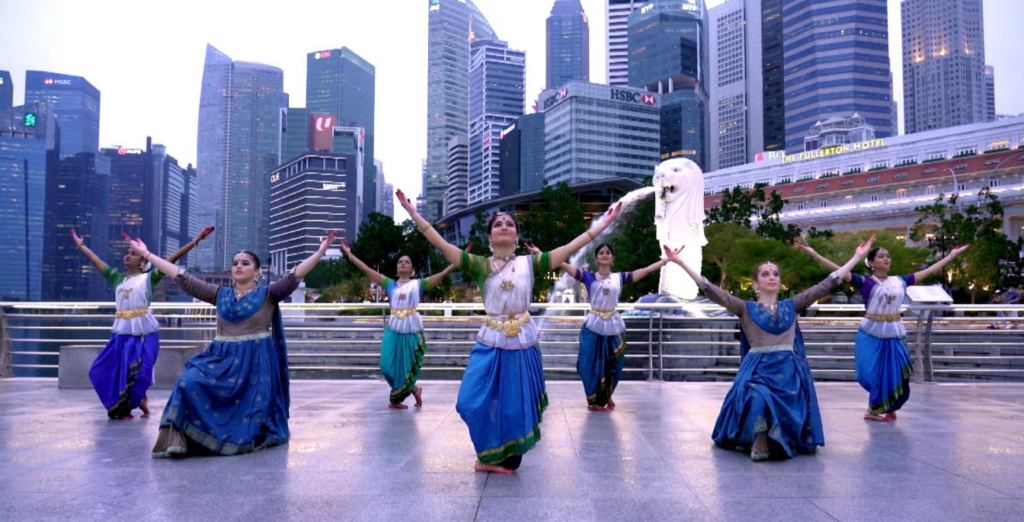
July-August has been an eventful month with the release of several digital productions supported by OurSGFund and Digital Grants by National Arts Council. Here is a sneak peek into select few beautiful locally produced creations that we highly recommend as must-watch: Stop & Smell the Roses by Maya Dance Theatre, Ripples by SIFAS and Crocodile Tears by Bhaskar’s Arts Academy. Stop & Smell the Roses By Maya Dance Theatre Stop & Smell the Roses was premiered by Maya Dance Theatre on August 10th as a screen dance performance. Conceived and created during the Covid-19 Circuit Breaker period, the project brought the stories of 17 dancers together in a dance production created, rehearsed and filmed independently from their own homes! Stop & Smell the Roses exposes the irony of our relationship with time. In our constant searching for material bounty, we negate the one thing that is limited …. Time! Artistic Director, Kavitha Krishnan, in her post production talk during a soft launch virtual event said about her own personal reflection that “Change is constant. We should not keep catching up with time, we need to slow down.” “It’s only when the whole world shuts down and we are forced into temporary lock down that we realise its true value. Do we feel restless when presented with an abundance of time? Imprisoned in a cell? Bored in the house? Or do we indulge in this newfound luxury to stop and smell the roses?” Artistic Director, Kavitha Krishnan partnered with Sharin Johry on the concept choreography and movement direction for frames, on this production. Credits: Creative Producer: Imran Manaff Music: Kailin Yong with Bharathanatyam vocal nattuvangam by Ajith Bhaskaran Das (Malaysia) and voice/music by Peni Candrarini (Indonesia) Screen dance direction by film maker/multimedia artist Yahssir M. Poetry by Aishwarya Prithviraj Poetry recitation by Ashwarya Prithiviraj, Kavitha Krishnan, Shahrin Johry Post production by Millennia Motion Pictures Watch SASTR : https://youtu.be/9QsbIP07MtU Ripples in a Storm: Reflections By Singapore Indian Fine Arts Society On August 8th, in celebration of Singapore’s 55th National Day, Singapore Indian Fine Arts Society released a music-video that reflects on how far we’ve come, unified as a community of people battling against the pandemic. SIFAS presented this Music-Dance collaboration by bringing together artistes from Singapore’s dance institutions (SIFAS, Bhaskar’s Arts Academy, Bharathaa Arts and Temple Of Fine Arts) in this youth-led collaboration. Credits: Artistic direction and choreography (Bharatanatyam & Contemporary) by Sheejith Krishna, Music composed, produced and arranged by Dr Rajkumar Bharathi and Sai Shravanam, Kathak choreography by Aamrapali Bhandari, this video features representatives of 4 organisations: SIFAS, Bhaskar’s Arts Academy, Bharathaa Arts and Temple Of Fine Arts Singapore. Watch Ripples : https://youtu.be/cQyo8pRUGWM Crocodile Tears By Bhaskar’s Arts Academy Based on a familiar tale from the Panchatantra fables, Bhaskars Arts Academy dancers created a digital production enacting three characters of a monkey and a family of crocodile dedicated to children. This production is supported by the National Arts council funds and features company dancers Bala Saravanan Loganathan, S Hemalatha and Nandhini Sathasivam Video editing credits: Soneiya Sony. Watch the Crocodile Tears: https://youtu.be/EDtilVZFxGg
Virtual Events
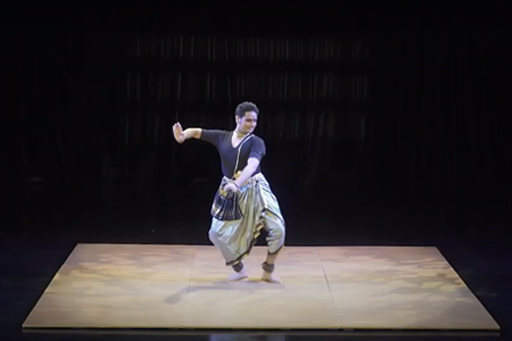
Here is a round up of digital events at Apsaras Arts over the last month. From the release of “Bhairava” in collaboration with Indian Raaga, an inaugural feature at the SPIC MACAY Singapore chapter to the Navrathri celebration by the students of Apsaras Arts Academy. The month has been busy for the Academy teachers preparing the students across all levels to perform in celebration of Navrathri festival. Subscribe to our You tube channel to follow the digital festival releases over this festive season. An International Veena Festival –Veena Mahotsavam 2020 organised by Harata Ilango Foundation for Asian Culture (BIFAC), Narada Ghana Sabha Trust & Kalakendra.com curated by Veena Vidwan Kannan Balakrishnan of Kalakendra Music. This online festival ran for 20 days from 26th September to 15th October 2020. Apsaras Arts’s Aravinth Kumarasamy performed on 3 October 2020 with overseas performers outside India under their series “Akhandam – III: Artistes from Abroad.” He performed a set of 3 ragas – “Samajavaragamana” in Ragam Hindolam, a Thiagaraja composition, followed by “Velliada Ittu Neram Ah” in Ragam Shanmugapriya and “Harivarasanam” in Ragam Madyamavathi. Watch the performance [at 6:00:00 to 6:25:00]: On October 11th SPIC Macay Singapore Chapter had an inaugural event to introduce its resurgence and new volunteers. The Zoom event featured volunteers from Indian Chapters and Australia and the leaders spoke about the movement which began in 1977 by Dr Kiran Seth and his peers. During this session, two Singaporean National Young Artist Award recipients were invited to speak about their artistic journeys. Aravinth Kumarasamy and Mohd Sufir Juwahir who both shared details of some of their dance related works and questions were posed to them by volunteers. Aravinth was asked about arts conservation in Singapore and he shared that in Singapore, arts education in local schools is increasingly curricular and the role of Indian arts has had a tremendous impact on South-East Asia. He said that much efforts by him (& Apsaras Ars) to reconnect Indian heritage and performing arts with our Asian cousins which over time has become assimilated and made Singaporean. He spoke about “Sangeetha” (the practice of Sadhana) and “Rasanubhava” which when brought together creates “Sahadya” (oneness). He also shared the positive support for local & traditional arts by the Singapore government through grants and arts housing. The session concluded with a Q&A session with participants who found the session illuminating. SPIC Macay Singapore Chapter aims to have long-term imprints on youth both in terms of life experiences and to incorporate the appreciation of the arts for a more enriching life. On October 17th, IndianRaga Singapore in partnership with Apsaras Arts Dance Company premiered a digital showcase of a solo dance item – “Bhairava” in which the popular Kala Bhairava Ashtakam slokam has been beautifully presented in a dance form by the talented artist Mohanapriyan Thavarajah. As is the legend, Bhairava is referred as the guardian of all Siva temples and in this composition of Adi Shankara, the Kala Bhairava Ashtakam brings out all the attributes of Bhairava and the boons that he grants to those who pray to him. The piece has been sung in Ragam Hamsadhwani and in Talam Chatusra Eka Tisra Gathi. Credits: Artistic Direction : Aravinth Kumarasamy Choreography: Sheejith Krishna Music composition: Bombay Jayashree Ramnath Singer:Deepu Nair Performed by: Mohanapriyan Thavarajah Watch at: From October 17th- 26th, Apsaras Arts Academy has been releasing new dance video performances by students from all disciplines that are taught at the Academy: Bharatnatyam, Kathak and Odissi. Navrathri Celebration performance schedule as follows: Please subscribe to Apsaras Arts Academy you tube channel:
An Interview with Lalitha Venkatasubramanian
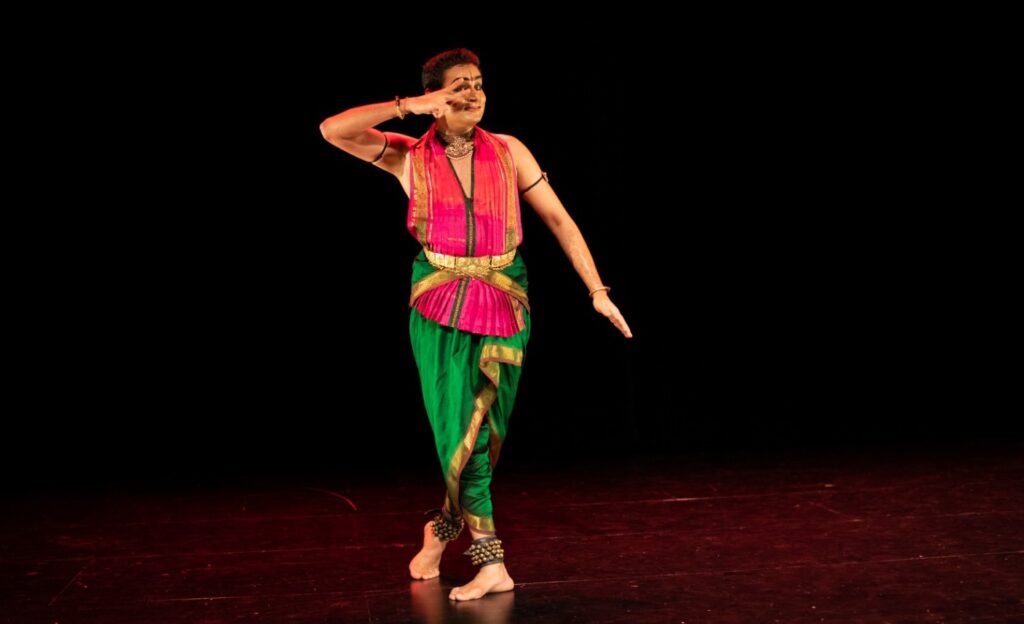
Finding life’s purpose through Dance & Mental Health Advocacy- an interview with Lalitha Venkatasubramanian By Vidhya Nair “The mantra that I try to live by is “try your best and do what you can”. Celebrating my own small successes is key to keeping myself motivated. Dance provides me with an oasis of calm, a refuge which I can turn to when the going gets tough. My own mental health journey was the impetus for my work “Finding Dignity – An exploration of mental illness through Bharatanatyam”. Apart from being a cathartic process for me, it allowed me to push the boundaries of Bharatanatyam – engaging the audience on an emotional level through art while putting across key messages on mental health issues.” Over the decades, Lalitha has been a student of dance which has helped shape her life and added meaning and purpose. She shares her reflections on her dance journey in this interview. VN: Tell us about your growing up years in Singapore and your early memories of family life. LV: I was born and brought up in Singapore as my parents had come to Singapore from India in the 1950’s. I am the youngest of 4 children, our childhood was centred around our studies but it was a carefree time. I recall many afternoons and evenings after school spent playing with neighbours on the streets of Sturrock and Piggott Road (off Balestier Road) where we lived. Two weekday afternoons were spent going for dance classes and on Sundays, it was a long sojourn involving 3 bus changes, to Branksome Road at Katong where I studied Carnatic vocal classes at the Singapore Indian Fine Arts Society (SIFAS). When SIFAS moved to Norris Road and then to the corner of Balestier Road/ Serangoon Road, I continued there. And briefly also learnt the Veena. Living around the Balestier area, visits to the Perumal Temple and the Vadapathra Kaliamman temple were very much a part of our daily routine. VN: What was your earliest memories of dance classes at Apsaras? LV: At Balestier, we were just around the corner from Kamala Club where Mami was conducting her classes. This is where I started my classes with Mami. Memories that stay with me are the mid-afternoon walks from home to Kamala Club in the intense heat. The whirring of the fans and the cool tiled floor were a welcome reprieve from the heat. For a skinny and tongue tied 12 year old, Mami appeared to be a larger than life figure, a formidable and fearsome presence. Yet, as I started the classes, it became clear that her teaching style was anything but fear inducing – firm yes, but gentle and patient at the same time. VN: What was your relationship like with Mami? LV: During my individual classes with Mami in the late 90’s and 2000’s, Mami provided a comforting presence – her classes were a home away from home. Entering her classroom during the afternoons with no one else around, transported me to a spiritual sanctuary. VN: How did you balance running a home, having children, raising them and having a career? LV: As most working mothers would attest to – it was not easy and I will definitely say that I was no super woman. There were several times over the years during which I took a few years’ hiatus from dance – when in university [ Lalitha graduated with a Bachelor of Accountancy from NUS and practiced as an accountant and tax consultant. She also earned a Masters in English Language (Teaching) and made a mid-career switch to teaching for some years. She has since reverted back to tax consultancy since 2015 on a freelance basis and has upgraded herself with relevant qualifications as recently as 2018] and when I had each of my 3 children. My husband Ramani, has been a pillar of support all these years – supporting me through the journey. He has always encouraged me to continue my passion and even after our busy work days, he would look after the children whenever I went for night classes with Mami, bringing them to fetch me from the late classes so that I could see them before they went to sleep. I have also benefited from having the support of good helpers along the way, a blessing which I humbly acknowledge that I am privileged to have. VN: With Mami now no more, how to you keep your connection to her teachings? LV: Dance has become a spiritual path for me – my yoga, my prayer, my connection with the divine. This I attribute to Mami – she used to emphasise the need for divinity in dance, to elevate oneself as well as the audience to a higher spiritual plane. An ethos, borne of the Kalakshetra tradition, lived and breathed by Mami – an ethos which she has passed on. VN: What has helped you retain your spark and interest in Bharatanatyam all these years? LV: Bharatanatyam transports me to a different world, beyond the mundane and over the years it has taken on a different significance in my life, becoming my personal spiritual journey. The breadth of the poetry and literature that it draws from, the depth of the abhinaya exploration that it allows for, the visual poetry that it creates, the divinity that is inherent in the form – these are aspects that, rather than just retain, have increased my interest in Bharatanatyam. I have also been encouraged by following the journeys of my fellow Singaporean dance mates, although our paths have been different, we are connected by our love of dance. In particular, I have been inspired by the wonderful work being done by Uma Chetty in Apsaras Arts, Virginia whose passion, enthusiasm and drive to propagate the art is truly amazing. I still have fond memories of the programme in 1993 done at the (then) PUB auditorium with both of us bonding over our shared accounting and dance experiences! VN: How to you keep up your own dance training? What does it take – as
An Interview with Lalitha Venkatasubramanian
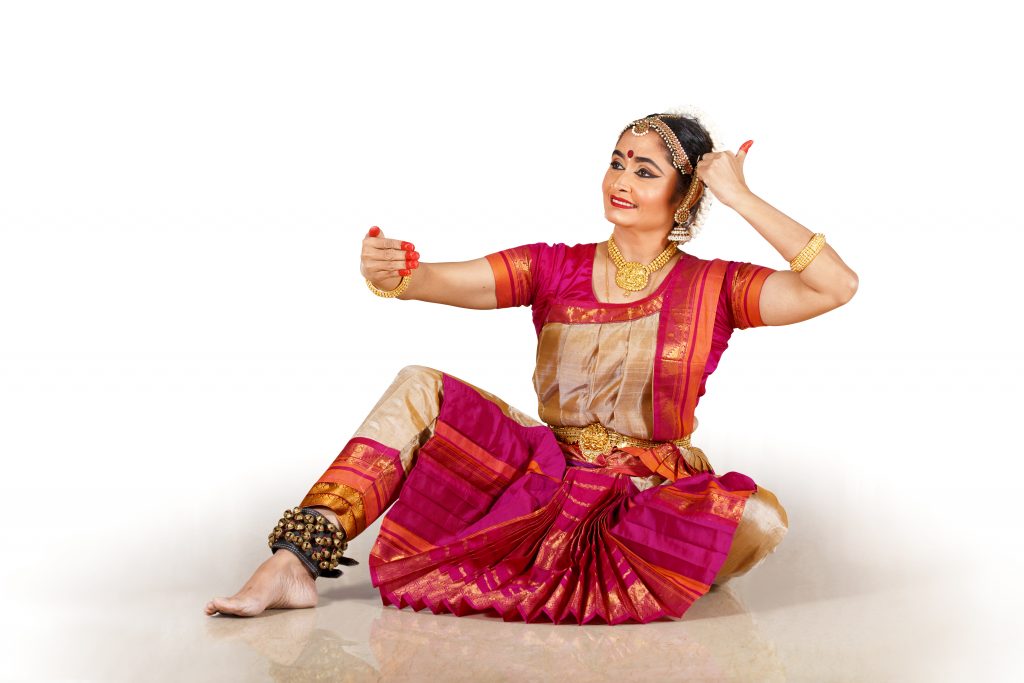
Finding life’s purpose through Dance & Mental Health Advocacy- an interview with Lalitha Venkatasubramanian By Vidhya Nair “The mantra that I try to live by is “try your best and do what you can”. Celebrating my own small successes is key to keeping myself motivated. Dance provides me with an oasis of calm, a refuge which I can turn to when the going gets tough. My own mental health journey was the impetus for my work “Finding Dignity – An exploration of mental illness through Bharatanatyam”. Apart from being a cathartic process for me, it allowed me to push the boundaries of Bharatanatyam – engaging the audience on an emotional level through art while putting across key messages on mental health issues.” Over the decades, Lalitha has been a student of dance which has helped shape her life and added meaning and purpose. She shares her reflections on her dance journey in this interview. VN: Tell us about your growing up years in Singapore and your early memories of family life. LV: I was born and brought up in Singapore as my parents had come to Singapore from India in the 1950’s. I am the youngest of 4 children, our childhood was centred around our studies but it was a carefree time. I recall many afternoons and evenings after school spent playing with neighbours on the streets of Sturrock and Piggott Road (off Balestier Road) where we lived. Two weekday afternoons were spent going for dance classes and on Sundays, it was a long sojourn involving 3 bus changes, to Branksome Road at Katong where I studied Carnatic vocal classes at the Singapore Indian Fine Arts Society (SIFAS). When SIFAS moved to Norris Road and then to the corner of Balestier Road/ Serangoon Road, I continued there. And briefly also learnt the Veena. Living around the Balestier area, visits to the Perumal Temple and the Vadapathra Kaliamman temple were very much a part of our daily routine. VN: What was your earliest memories of dance classes at Apsaras? LV: At Balestier, we were just around the corner from Kamala Club where Mami was conducting her classes. This is where I started my classes with Mami. Memories that stay with me are the mid-afternoon walks from home to Kamala Club in the intense heat. The whirring of the fans and the cool tiled floor were a welcome reprieve from the heat. For a skinny and tongue tied 12 year old, Mami appeared to be a larger than life figure, a formidable and fearsome presence. Yet, as I started the classes, it became clear that her teaching style was anything but fear inducing – firm yes, but gentle and patient at the same time. VN: What was your relationship like with Mami? LV: During my individual classes with Mami in the late 90’s and 2000’s, Mami provided a comforting presence – her classes were a home away from home. Entering her classroom during the afternoons with no one else around, transported me to a spiritual sanctuary. VN: How did you balance running a home, having children, raising them and having a career? LV: As most working mothers would attest to – it was not easy and I will definitely say that I was no super woman. There were several times over the years during which I took a few years’ hiatus from dance – when in university [ Lalitha graduated with a Bachelor of Accountancy from NUS and practiced as an accountant and tax consultant. She also earned a Masters in English Language (Teaching) and made a mid-career switch to teaching for some years. She has since reverted back to tax consultancy since 2015 on a freelance basis and has upgraded herself with relevant qualifications as recently as 2018] and when I had each of my 3 children. My husband Ramani, has been a pillar of support all these years – supporting me through the journey. He has always encouraged me to continue my passion and even after our busy work days, he would look after the children whenever I went for night classes with Mami, bringing them to fetch me from the late classes so that I could see them before they went to sleep. I have also benefited from having the support of good helpers along the way, a blessing which I humbly acknowledge that I am privileged to have. VN: With Mami now no more, how to you keep your connection to her teachings? LV: Dance has become a spiritual path for me – my yoga, my prayer, my connection with the divine. This I attribute to Mami – she used to emphasise the need for divinity in dance, to elevate oneself as well as the audience to a higher spiritual plane. An ethos, borne of the Kalakshetra tradition, lived and breathed by Mami – an ethos which she has passed on. VN: What has helped you retain your spark and interest in Bharatanatyam all these years? LV: Bharatanatyam transports me to a different world, beyond the mundane and over the years it has taken on a different significance in my life, becoming my personal spiritual journey. The breadth of the poetry and literature that it draws from, the depth of the abhinaya exploration that it allows for, the visual poetry that it creates, the divinity that is inherent in the form – these are aspects that, rather than just retain, have increased my interest in Bharatanatyam. I have also been encouraged by following the journeys of my fellow Singaporean dance mates, although our paths have been different, we are connected by our love of dance. In particular, I have been inspired by the wonderful work being done by Uma Chetty in Apsaras Arts, Virginia whose passion, enthusiasm and drive to propagate the art is truly amazing. I still have fond memories of the programme in 1993 done at the (then) PUB auditorium with both of us bonding over our shared accounting and dance experiences! VN: How to you keep up your own dance training? What does it take – as
Dancing the Stories of Banteay Srei
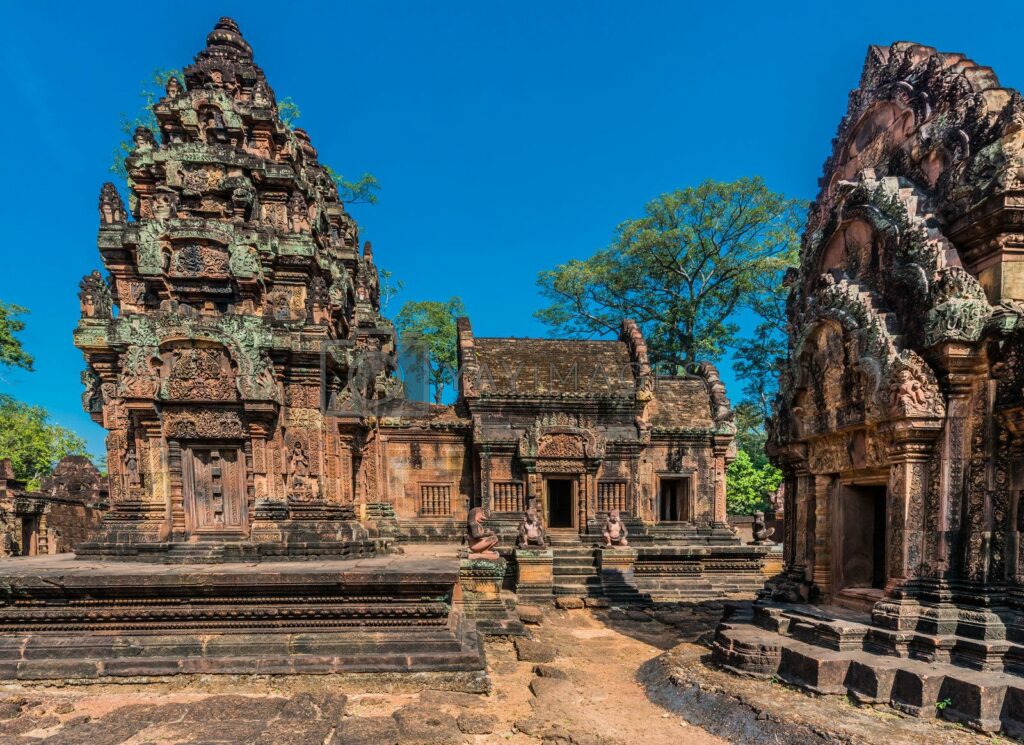
AMARA: Dancing the Stories of Banteay Srei Inspired by the legends and the stories carved in its bas reliefs of the enchanting temple of Banteay Srei, this dance production brings to life the female divine Yoginis of the temple, which was once called the “citadel for women.” Apsaras Arts Dance Company is proud to present this new production next month from November 20- 28th at the Kalaa Utsavam 2020 at Esplanade Theatres on the Bay. Get your tickets now! As a Curtain-Raiser Performance for Kalaa Utsavam 2020, next month, from 20th to 28th November 2020, Apsaras Arts is proud to present a brand new dance production, “Amara – Dancing the Stories of Banteay Srei.” This is a dance production inspired by the legends and the stories carved in its bas reliefs choreographed in Indian classical dance style of Bharatanatyam. The imagination of the choreography brings to life the female divine Yoginis of the temple, which was once called the “citadel for women”. The dancers evoke the characters from tales of the two Hindu epics – Ramayana and Mahabharata detailed in the temple’s pink stone walls. About Banteay Srei The enchanting temple of Banteay Srei holds a special charm that lies in its remarkable state of preservation, small size and excellence of intricate decoration. The unanimous opinion amongst French archaeologists who worked at Angkor is that Banteay Srei is a ‘precious gem’ and a ‘jewel in Khmer art’. Banteay Srei, as it is known by locals, was originally called Isvarapura, according to inscriptions. It was built by a Brahmin of royal descent who was spiritual teacher to Jayavarman V. Some describe it as being closer to architecture and decoration to Indian models that any other temple at Angkor. A special feature of the exquisite decoration was the use of a hard-pink sandstone (quartz arenite) which enabled the ‘technique of sandalwood carving with even an Indian scent to it’. The architecture is distinguished by triple superimposed frontons with relief narrative scenes carved in the tympanums, terminal motifs on the frames of the arches, and standing figurines in the niches. Panels are decorated with scenes inspired by Indian epics, especially the Ramayana and its execution has a liveliness not seen in the more formal decoration of earlier temples. The temple was discovered by the French in 1914, but the site was not cleared until 1942. The theft of several important pieces of sculpture and lintels by a European expedition, meticulously planned by the young Frenchman, Malraux, caused a great scandal in 1923, but hastened the archaeological work. The thieves were held under house arrest in Phnom Penh and only released after the return of the stolen pieces. Banteay Srei is the first temple at Angkor to have been completely restored by the process of anastylosis, after the EFEO studied this method at Borobudur on the island of Java in Indonesia. Compared to the rest of Angkor this temple is in miniature. The doors of the central towers are narrow and barely one-and-a-half metres (five feet) in height. The quality of architecture and decoration make up for any shortcomings in size. As Maurice Glaize wrote, Banteay Srei is ‘a sort of “caprice” where the detail, of an abundance and incomparable prettiness, sweeps away the mass’. *This production is Apsaras Arts Dance Company’s core repertory work and premieres at Kalaa Utsavam 2020, annual performing arts festival curated and presented by Esplanade Theatres on the Bay, Singapore. In this year’s digital edition, AMARA will premiere on 20th November 2020 and remain available for viewing till 29th November 2020. Tickets go on sale from 20th October on SISTIC.
Dance India Asia Pacific 2020 Music
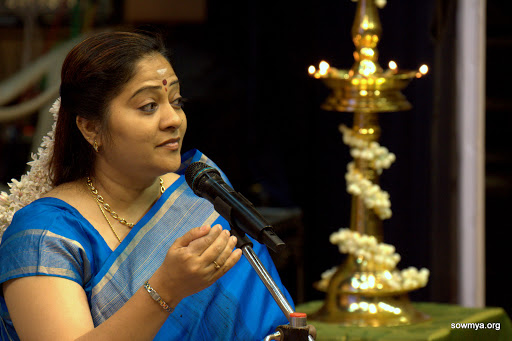
By Sushma Soma “This has been a difficult year for many of us, but it was so gratifying to have a week filled with art with artists par excellence and I am excited to see what the future music sessions of DIAP will bring for us musicians!” summarises Sushma Soma about her experience on attending the inaugural masterclass music program at the DIAP 2020. Every year when Dance India Asia Pacific starts posting its schedule and I start feeling the palpable buzz amongst the dancers in Singapore, a part of me would envy them. I would wonder ‘Ah, when can we have a similar residency programme for musicians?’ And just like that, DIAP read my mind and debuted an unforgettable music initiative this year. With Dr S Sowmya leading a padam session, Sikkil Gurucharan leading a Manodharma & Ragam Tanam Pallavi workshop, Patri Satishkumar leading a Sankeerana Nadai in Mridangam workshop, DIAP ensured that it had something for every different Carnatic vocalist and mridangam artist. Initially, as all the participants conversed, we were all daunted by the fact that we’d have to sing and perform in our respective sessions in front of the doyens. However, this worry was put to rest when the artists from India reassured everyone that there was absolutely nothing to feel conscious about and this was a safe space for everyone to learn. We made mistakes and we learnt from them. Sowmya akka as she was respectfully called by all of us, generously shared with us the padam, ‘Pusadaramu’ that she learnt from T Muktha of the legendary T Brinda and T Muktha duo. She patiently taught us every nuance, emphasised on the importance of ending a sahitya a particular way and the importance of highlighting a ghamakam a certain way – she made it very clear that she held the patantaram with utmost reverence and that we had the responsibility of receiving it and singing it with that same respect. Many of us were new to the padam form, hence took considerable amount of time to grasp the flow and nuances. However, Sowmya akka was insistent (even more so than us) that we did not rush the learning process and she repeated each line multiple times until we understood it. While we felt guilty that the session had to be extended to the following week, Sowmya akka carried with her the same excitement and passion to share this gem in Todi Raga as she did on the first day. For this and more, we are all so grateful to her and DIAP for giving us this opportunity! While emphasising that manodharma is a lifelong pursuit and it cannot be fully learnt in 3 days, Sikkil Gurucharan gave the participants a treasure box of tips and useful methods which set a strong base upon which the participants can build their manodharma. Working with a Pallavi set in Pantuvarali Raga “Guruvina Gulaamanaaguva Thanaka, Doraya Danna Mukuthi”, participants learnt about the jeevaswaram in each raga. From building a tanam to neraval to kalpana swaram and lastly to even creating their own pallavi, the participants were exposed to every facet of the RTP. I was particularly intrigued by how one could work on the trikala exercise or 3 speeds exercise using just S R G M P D N S and corresponding words Sha ra va na bha va gu ha. Sikkil Gurucharan ensured that every participant had the opportunity to share his/her work, hence ensuring the participants did not miss the in-person interaction as much. Apart from the workshops, there was a lec-dem by Sowmya akka on “Padams and Javalis from the Brinda Muktha school”. It was inspiring to hear how they would not change any sangati and sang it exactly the same way every time they rendered it and passed it down to their disciples too. It was also interesting to note that padams explored the idea of Shringara through ghana ragas, which made me wonder as a vocalist how I could bring out the Shringara rasa while singing a Bhairavi or Todiraga. This has been a difficult year for many of us, but it was so gratifying to have a week filled with art with artists par excellence and I am excited to see what the future music sessions of DIAP will bring for us musicians!
Path to Visualising Tyagaraja Kritis
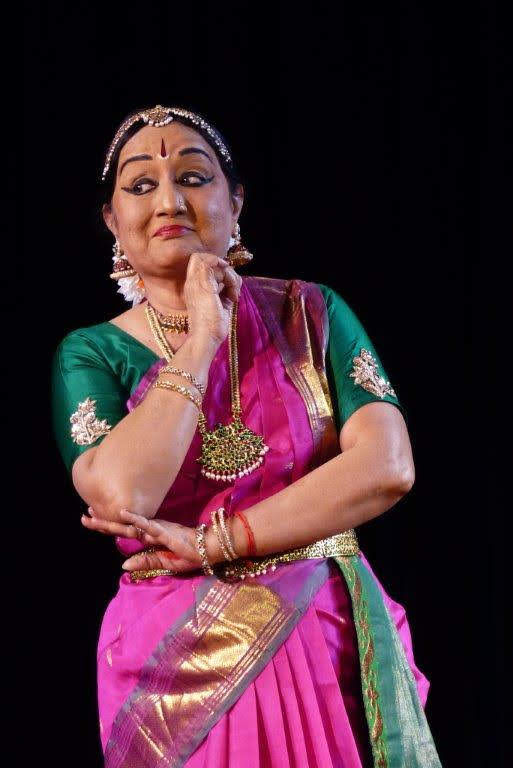
By Lakshmi Vishwanathan Distinguished Guest Column “Having shared my nine steps to visualise Tyagaraja kritis, I must point out that it is possible to dance to many of them, provided the dancer can evoke a chord of devotion to Rama.” Lakshmi Vishwanathan speaks about the intimate connection of Tyagaraja’s kritis that is both moving and poetic. I belong to a Thanjavur ancestry. Therefore, the songs of Tyagaraja were literally the melodies I woke up to. My mother sang and played them on the Veena as her personal offering to Rama. Learning vocal music from a young age created a singing repertoire for me which was rich in range : from the demanding Pancharatnas to the evocative poems in melodious ragas of which Tyagaraja was the exclusive master. With the early foundations laid by great gurus like Kanjivaram Ellappa, I understood dance as visual music. After years of mastering and performing the traditional pieces of Bharatanatyam, I took up the challenge of enlarging my repertoire with other music that is inspirational. An exclusive performance based on Tyagaraja’s compositions, a special programme for Doordarshan in 1986 made me go deep into a study of chosen compositions. The work was pure pleasure, and the result, amazing.The rare Harikambodhi piece “Sri Raghuvara” with swaras and sahithya proved to be an engaging opener. I composed dance for the kriti “Ksheerasagara Sayana” in Devagandhari. The way Tyagaraja weaves mythology into his songs with just a few words gives scope for elaborations with the phrases repeated in a variety of sangathis. With subtlety and suggestive abhinaya I wove the episodes of Gajendra moksha and of Draupadi into the dance choreography with telling effect.Taking a few phrases and elaborating on the theme is what abhinaya is all about. It is thus that I embarked on bringing out episodes of the Ramayana using appropriate Tyagaraja kritis. A challenging task in the beginning, it slowly evolved into an exercise of pure musical exploration and indulgence of imagination. With “Ela Nee Dayaradha” ( Bala Kanakamaya) in Atana Ragam, I introduced the child Rama and his siblings, gliding into the portrayal of their gurukula vasam. Artistic licence is a permissible luxury in dance interpretation. One has to tread carefully though, knowing that many in the audience may be Tyagaraja experts. However my creative impulses had to be used, given such an opportunity to explore the works of a great composer. I had to unfold the salient episodes of the Ramayana with the little nuggets provided by Tyagaraja. They are really hidden treasures. The story goes that Tyagaraja composed “Nannupalimpa” in Mohana Ragam, seeing his brother walking towards him with a picture of Rama. In my visualistion, the words :”Na prana nadha ” evoked the feelings of Sita when she first set her eyes on the young Rama entering Mithila. That is exactly what I portrayed in my dance ….not only the jump in Sita’s heart when she saw Rama, but also the stillness and utterly mesmerised reaction of every woman in Mithila who set her eyes on Rama. One cannot find Tyagaraja dwelling at length on any Ramayana episodes. Sometimes a single phrase by its shear beauty of rendition can touch your mind. One such is the way D.K.Pattammal used to sing the kriti “Sri Rama Padama” in ragam Amrithavahini . The amazing soulfulness in the mingling of music and lyrics in the phrase ” soora Ahalyanu joochi brochithivi ” moved me to choreograph this Kriti with the episode of Ahalya moksham coming to the fore. In the kriti in Madhyamavathi ragam, ” Nadhupai”, a certain phrase caught my imagination. It is :” Ajanubahuyuga Sri Janaki Pathi”, descriptive of Rama’s long, well built arms. In a demonstration at the Music Academy, with my sister Vidushi Charumathi Ramachandran doing a perfect nereval of Ajanubahu, I danced a detailed description of not only the majestic Rama and his valorous persona, but also wove into it the entire episode of the Sita swayamvaram, culminating in Rama lifting the bow of Shiva effortlessly. As I recall, the expert of the day K. Chandrasekara Iyer commented in a pithy manner : ” this was worthy of a Bala”. A rare kriti is “Vachamakochara” in the ragam Kaikavasi . Nobody can sing it with the verve and vigour of M.S.Subbulakshmi. Looking for a suitable song with a phrase to elaborate the Maricha episode, I found this gem. Using instruments to do the neraval I could build on the moods of Sita, her falling prey to deception, and her abduction at the hands of Ravana. Attracted by the simple lyrics and the plaintive tune prompted me to use “Nannu Vidachi” in the ragam Rithigowla, and transpose it from the pathos of Prahlada to the plight of Sita in the Ashoka Vanam. It worked beautifully. So did “Eti Janmam” in the ragam Varali. The lyrics of Tyagaraja and the ragams that he has used are the delight of a connoisseur. He has melded Raga and Bhava in a golden mesh that it became inevitable for me to weave the soul of abhinaya into the pattern. I recall Maharajapuram Santhanam attending this Tyagaraja Ramayana performance of mine and remarking later : ” Those kritis will never be the same again for me”. Having shared my nine steps to visualise Tyagaraja kritis, I must point out that it is possible to dance to many of them, provided the dancer can evoke a chord of devotion to Rama. Tyagaraja sings with an intimacy that is both moving and poetic, quite like the songs of Bhadrachala Ramadas. The plaintive Bhakti , the longing of the jeevathma for the paramathma creates a certain mood worthy of mature abhinaya. On the other hand it is difficult to dance to the Pancharatna kritis. The one that I chose to dance is “Sadinchene” in Arabhi ragam, largely because the theme is based on Krishna the playful lover. The sub- text of Tyagaraja kritis is spiritual. Bhakti Bhava reigns supreme. However if one studies the songs carefully one can find
From the Bookshelf
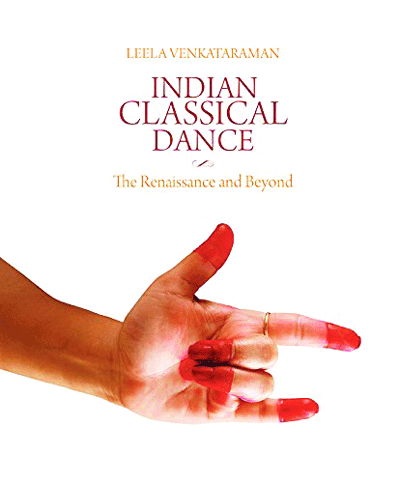
Indian Classical Dance: The Renaissance and Beyond By Leela Venkataraman Indian Classical Dance: The Renaissance and Beyond traces the journey of the evolution of Indian classical dance since the years of independence. Covering the eight classical dance forms of India – Bharatanatyam, Kathak, Kuchipudi, Kathakali, Manipuri, Mohiniattam, Odissi and Sattriya – Leela Venkataraman seamlessly weaves together a historical perspective with the contemporary scenario.Stripped of their association with the temple and the court, classical dance traditions in India went through a period of unprecedented changes in the period marking the last few years of British rule and thereafter. From becoming part of the nationalist struggle when India was trying to recover its lost identity, to sharing the international stage today with dance forms from all over the world, the last sixty-six years have seen many changes in perspective and presentation of Indian Classical Dance – some intentional, others involuntary. While looking at these years closely and their impact on dance forms, one realises that this is a phase in an ongoing process, with each new generation of dancers and musicians adding to an already rich tapestry of tradition. The book, Indian Classical Dance: The Renaissance and Beyond is beautifully illustrated, and multi-faceted, dealing with various aspects of dance, including sponsorship and patronage, the teacher/disciple relationship and the contemporary classical dialectic. Unique in its vast range of covering all the classical forms, Indian Classical Dance is a must read for dancers and dance historians, students and teachers of dance and those interested in this fascinating field of Indian culture. About the Author: Leela Venkataraman’s career as a writer on Dance began in 1980 as dance critic for The National Herald and later the Patriot Associated with the daily The Hindu for over thirty years, her Friday Review column has earned her a wide reputation for her incisive commentary on the dance scene. Widely travelled, she has been a regular participant in dance seminars in India and abroad. A prolific writer and regular contributor to dance journals like Nartanam and Sruti, she is the author of books Tradition in Transition, Step by Step Bharatanatyam, A Dancing Phenomenon – Birju Maharaj, and a book commissioned by the Children’s Book Trust on Indian Classical Dances. Her work and contribution have earned her the prestigious Sangeet Natak Akademi Award.
What’s Your Dance Voice?
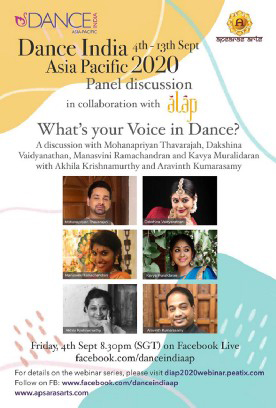
Gearing up for a panel discussion with four young dancers and discussing with them their individual, intrinsic voice in dance. Sharing the moderation mike with the amazing Aravinth Kumaraswamy, Artistic Director, Apsaras Arts